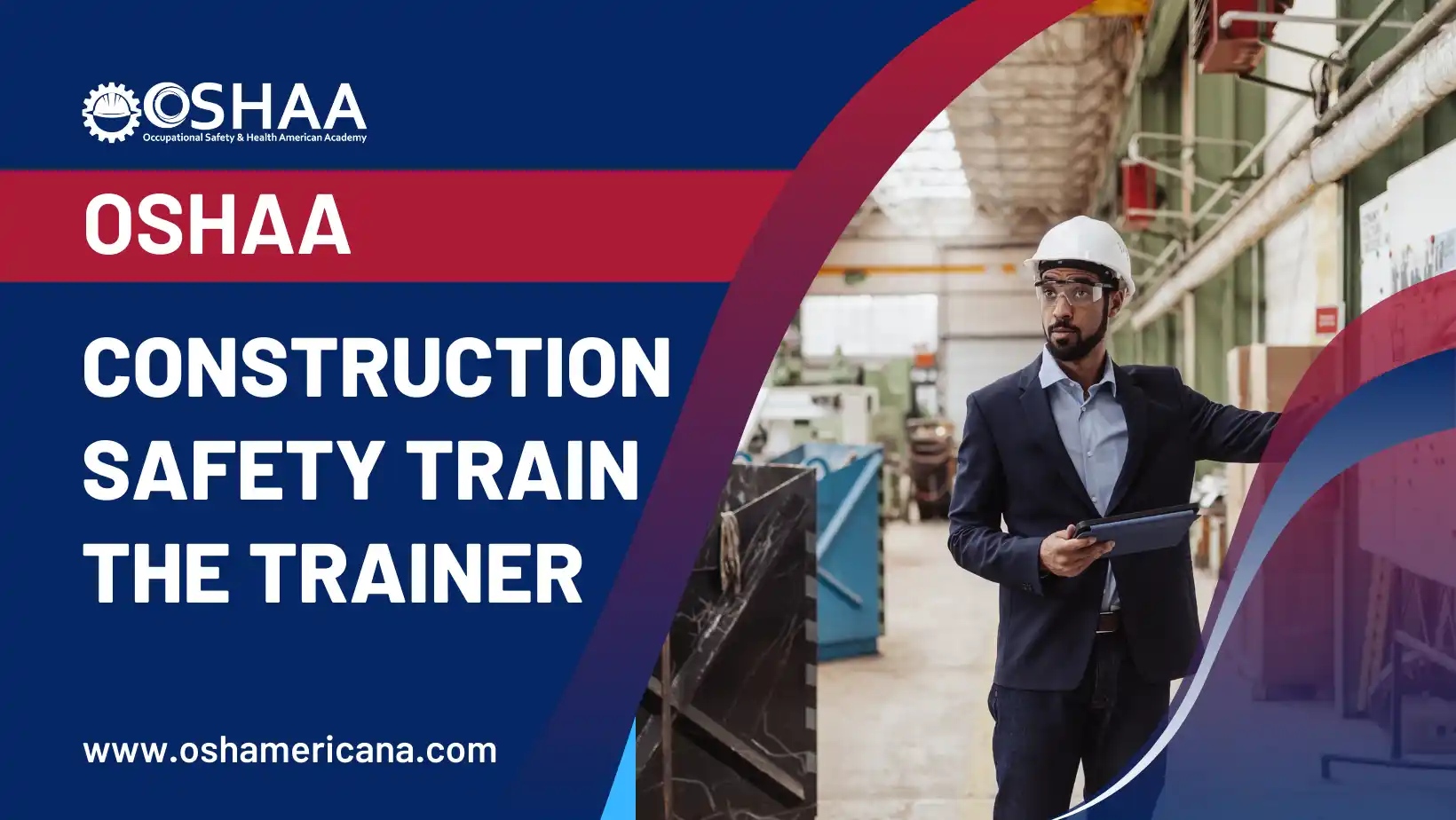Enhance your expertise with the OSHAA Construction Safety Train the Trainer course. Gain skills to lead safety programs, ensure compliance, and reduce risks on construction sites.
In the demanding and high-risk field of construction, maintaining safety is not just about meeting regulatory obligations but about safeguarding lives and promoting a culture of responsibility. The OSHAA Construction Safety Train the Trainer course has been carefully designed to provide professionals with the knowledge, confidence, and skills required to deliver effective safety training tailored to the unique challenges of the construction industry. By focusing on both compliance and leadership, the course empowers participants to become influential safety trainers who can positively shape workplace practices and outcomes.
Developed by the Occupational Safety and Health American Academy (OSHAA), the OSHAA Construction Safety Train the Trainer course addresses critical safety concerns that construction professionals encounter daily. This comprehensive program covers essential OSHA construction standards and regulations, with an emphasis on areas such as fall protection, scaffolding safety, hazard communication, and the management of hazardous materials. Each topic is structured to ensure participants not only understand the regulatory requirements but also learn how to translate this knowledge into practical training programs that improve safety performance on worksites.
What sets the OSHAA Construction Safety Train the Trainer course apart is its dual focus on technical expertise and training methodology. Participants are equipped with advanced instructional strategies that enable them to design, deliver, and evaluate safety training sessions with measurable impact. Beyond technical safety knowledge, the program emphasizes leadership, communication, and engagement skills, ensuring trainers can connect with diverse workforces and foster a proactive approach to hazard prevention.
This course is more than a professional development opportunity—it is a pathway to becoming a trusted authority in construction safety. Whether you are a safety officer responsible for regulatory compliance, a construction manager overseeing operations, or an industry professional aspiring to expand your role as a safety leader, the OSHAA Construction Safety Train the Trainer course equips you with the resources and expertise to make a meaningful difference. By completing the program, participants not only strengthen their personal career prospects but also contribute to reducing workplace incidents, improving organizational efficiency, and enhancing overall worker well-being.
Ultimately, the OSHAA Construction Safety Train the Trainer course is a cornerstone for building safer, more compliant, and more productive construction environments. By investing in this program, individuals and organizations alike demonstrate their commitment to safety excellence, regulatory adherence, and long-term professional growth. This course empowers participants to become catalysts for change in the construction industry, ensuring that safety is prioritized at every stage of a project and that teams work with confidence under the guidance of well-trained leaders.
OSHAA Construction Safety Train the Trainer
To enroll in the OSHAA Construction Safety Train the Trainer course, learners are expected to meet the following criteria:
Age Requirement
- Applicants must be at least 18 years old to participate in the OSHAA Construction Safety Train the Trainer course, ensuring they meet the minimum legal and professional standards for safety training roles.
Educational Background
- A high school diploma or equivalent is recommended for enrollment in the OSHAA Construction Safety Train the Trainer course.
- Higher education in construction, occupational safety, or related fields is considered an advantage, as it enhances understanding of technical content and regulatory frameworks.
Work Experience
- Prior experience in construction, safety management, or related industries is recommended for those enrolling in the OSHAA Construction Safety Train the Trainer course.
- While not mandatory, professional background in supervising, training, or enforcing safety compliance provides learners with valuable context to maximize the benefits of the program.
English Proficiency
- Learners must have the ability to read, write, and communicate effectively in English to fully engage with course materials and OSHA construction safety standards.
- Proficiency in English ensures participants can understand regulatory requirements, develop training programs, and deliver effective safety instruction across diverse workplace settings.
The OSHAA Construction Safety Train the Trainer course maintains rigorous eligibility standards to ensure that participants are prepared to excel as effective safety leaders. Meeting these requirements equips learners with the foundation needed to successfully complete the program and apply their training to improve safety compliance, operational efficiency, and workplace culture.
Study Units
Learning Outcomes
The Learning Outcomes of the OSHAA Construction Safety Train the Trainer course are designed to provide participants with the advanced knowledge, technical expertise, and leadership skills necessary to excel as safety trainers in the construction industry. This course equips learners with practical competencies that not only strengthen compliance with OSHA standards but also enhance their ability to design, deliver, and evaluate impactful safety programs that drive long-term cultural change in organizations. By completing this course, participants gain the confidence and skills to lead safety initiatives, protect workers, and promote regulatory adherence at all levels of construction operations.
- Introduction to Construction Safety Standards
- Gain a thorough understanding of OSHA construction safety standards and their global relevance to workplace compliance.
- Learn how to interpret, apply, and communicate key safety regulations across diverse construction environments.
- Develop the ability to align organizational safety practices with national and international compliance frameworks.
- Hazard Identification and Risk Management
- Acquire skills to identify common and complex hazards in construction worksites, from fall risks to chemical exposures.
- Learn systematic approaches to risk assessment, prioritization, and control measures in line with OSHA requirements.
- Apply proactive risk management strategies to minimize workplace accidents and improve operational efficiency.
- Designing Effective Training Programs
- Develop the ability to design structured construction safety training programs tailored to workforce needs.
- Learn to incorporate OSHA standards, industry best practices, and adult learning methodologies into training materials.
- Gain skills in creating adaptable training modules that support compliance and long-term knowledge retention.
- Training Delivery Techniques
- Master effective training delivery methods, including classroom instruction, on-site demonstrations, and digital platforms.
- Learn how to engage diverse learner groups and adapt communication styles to maximize understanding.
- Build confidence in using visual aids, case studies, and interactive tools to deliver impactful safety sessions.
- Communication and Leadership Skills
- Enhance leadership capabilities to inspire, motivate, and influence teams toward adopting safe work practices.
- Strengthen communication skills for effectively delivering complex safety information to various audiences.
- Develop conflict resolution and coaching techniques to support a positive and proactive safety culture.
- Emergency Preparedness and Response
- Gain expertise in developing and implementing emergency action plans tailored to construction sites.
- Learn to train teams in evacuation procedures, first aid, and incident reporting in compliance with OSHA guidelines.
- Build the capacity to lead rapid, effective responses to emergencies while minimizing risks and ensuring worker safety.
- Evaluation and Continuous Improvement
- Develop skills to assess the effectiveness of safety training programs through feedback and performance metrics.
- Learn to apply continuous improvement models to refine training strategies and align with evolving OSHA standards.
- Gain the ability to foster a culture of accountability and innovation that strengthens organizational safety performance.
By completing the OSHAA Construction Safety Train the Trainer course, participants will be fully prepared to lead safety initiatives, ensure compliance with OSHA construction safety standards, and build a culture of proactive risk management. This course empowers professionals to act as influential trainers and leaders, driving safer practices, reducing workplace incidents, and advancing long-term organizational success in the construction industry.
The OSHAA Construction Safety Train the Trainer course offers a wide range of benefits that empower professionals, organizations, and stakeholders to achieve excellence in workplace safety, compliance, and training effectiveness. This program is designed not only to enhance technical knowledge of OSHA construction standards but also to build advanced leadership, communication, and instructional skills. Globally relevant and aligned with international safety frameworks, the OSHAA Construction Safety Train the Trainer course ensures participants are equipped to meet regulatory requirements, reduce risks, and promote a culture of safety. Beyond compliance, the course supports professional development, operational efficiency, and long-term career growth for individuals working in high-risk construction environments.
- Comprehensive Knowledge of OSHA Standards
Participants gain an in-depth understanding of OSHA construction safety regulations, including fall protection, scaffolding, hazard communication, and personal protective equipment. This ensures trainers can deliver accurate and compliant safety programs across diverse work environments. - Enhanced Hazard Identification Skills
The course strengthens the ability to recognize potential hazards on construction sites, assess risks, and implement control measures. This skill reduces workplace accidents, safeguards employee well-being, and enhances organizational safety performance. - Regulatory Compliance and Legal Protection
By mastering OSHA standards, learners ensure their organizations remain compliant with national and international regulations. This reduces the risk of legal penalties, improves audit readiness, and reinforces stakeholder trust. - Development of Effective Training Programs
Participants learn to design and structure comprehensive training programs tailored to workforce needs. This includes applying adult learning principles, incorporating case studies, and utilizing engaging training materials for maximum impact. - Improved Training Delivery Techniques
The course equips learners with practical delivery methods such as on-site demonstrations, interactive workshops, and digital tools. This enables trainers to adapt to diverse audiences and deliver sessions that are both engaging and effective. - Leadership and Communication Skills
Professionals enhance their ability to lead safety initiatives, motivate teams, and communicate complex safety requirements clearly. These skills support the development of a proactive safety culture across construction operations. - Emergency Preparedness and Risk Management
Participants gain the expertise to prepare for emergencies through structured evacuation plans, first-aid training, and incident response strategies. This ensures rapid and effective responses that minimize damage and protect workers. - Workplace Safety and Incident Reduction
Through advanced training skills, graduates can implement practices that reduce workplace accidents and injuries. This contributes to improved worker morale, higher productivity, and a safer working environment. - Professional Development and Career Advancement
Completing the OSHAA Construction Safety Train the Trainer course enhances professional credibility, opening pathways to leadership roles in construction safety and training management. It also provides recognition as a certified trainer capable of leading organizational change. - Cost Savings and Operational Efficiency
Effective training leads to fewer workplace incidents, reduced downtime, and lower compensation claims. Organizations benefit from streamlined operations, improved efficiency, and long-term financial savings. - Continuous Improvement in Training Programs
Learners develop skills in evaluating and refining training initiatives through feedback and performance analysis. This ensures that safety training remains current, effective, and aligned with evolving OSHA regulations. - Global Recognition and Relevance
The OSHAA Construction Safety Train the Trainer course is recognized internationally, making it valuable for professionals working in multinational organizations or global construction projects. This recognition enhances career mobility and professional standing. - Building a Strong Safety Culture
Graduates of the program are prepared to act as catalysts for cultural change within their organizations. By promoting shared responsibility and continuous awareness, they create workplaces where safety becomes a collective priority. - Innovation in Training Approaches
Participants are encouraged to integrate technology, multimedia tools, and innovative strategies into safety training. This ensures programs remain engaging, modern, and effective in reaching diverse workforce groups. - Long-Term Organizational Resilience
By reducing risks, enhancing compliance, and fostering leadership, the course supports long-term sustainability and resilience in construction organizations. This positions companies for growth, stability, and competitive advantage.
The OSHAA Construction Safety Train the Trainer course delivers more than regulatory knowledge—it builds leaders who can shape safer construction environments, improve organizational performance, and advance their professional careers. By completing this program, participants are equipped to design and deliver impactful safety training, ensure compliance, and contribute to a culture of excellence in construction safety worldwide.
The OSHAA Construction Safety Train the Trainer course is designed for professionals and organizations committed to improving workplace safety, ensuring compliance with OSHA standards, and building a culture of risk prevention within the construction industry. This course is particularly relevant to individuals in supervisory, safety, and compliance roles who are responsible for leading training, overseeing workers, and implementing health and safety programs. With global recognition and alignment to OSHA regulations, the OSHAA Construction Safety Train the Trainer course offers professional development opportunities that support compliance, organizational efficiency, and leadership in high-risk industries.
- Safety Professionals
- Safety managers and officers responsible for implementing workplace safety programs in construction projects.
- The course helps them enhance training capabilities and deliver OSHA-compliant instruction to their teams.
- Participants gain advanced knowledge of construction safety standards and effective training strategies.
- This ensures their organizations maintain OSHA compliance, reduce risks, and foster a proactive safety culture.
- Supervisors and Operations Managers
- Supervisors and managers overseeing daily construction site operations where safety is a critical responsibility.
- The OSHAA Construction Safety Train the Trainer course equips them with tools to lead safety initiatives effectively.
- They acquire leadership and communication skills essential for guiding workers and reinforcing compliance.
- By completing this training, managers strengthen operational safety, improve team performance, and minimize incidents.
- Human Resources and Training Coordinators
- HR professionals and coordinators involved in workforce training, development, and compliance requirements.
- This course enables them to design and implement OSHA-aligned construction safety training programs.
- They gain insight into developing engaging training materials tailored to different learning needs.
- Their role in compliance and workforce safety is strengthened, ensuring consistency across organizational training.
- HSE Officers and Compliance Specialists
- Environmental, health, and safety officers tasked with ensuring adherence to OSHA and regulatory requirements.
- The OSHAA Construction Safety Train the Trainer course enhances their ability to deliver structured safety programs.
- They learn to conduct risk assessments, hazard identification, and targeted training sessions.
- This ensures compliance is met while also fostering an environment of continuous safety improvement.
- Construction Consultants and Independent Trainers
- Consultants and trainers who provide safety services to organizations across construction and related sectors.
- The course equips them with advanced methodologies for training delivery and OSHA standard application.
- They gain credibility and recognition as certified trainers capable of meeting diverse organizational needs.
- Their services become more impactful, driving compliance and improving safety outcomes across projects.
- Industry Professionals in High-Risk Sectors
- Construction workers, foremen, and professionals in high-risk trades such as scaffolding, roofing, and heavy machinery operations.
- The course provides them with the skills to transition into leadership roles as trainers.
- They gain practical knowledge of hazard prevention and OSHA safety regulations tailored to construction.
- This supports compliance, reduces accidents, and improves workforce productivity and confidence.
- Educational Institutions and Instructors
- Vocational school instructors, technical educators, and university faculty involved in safety and construction programs.
- The OSHAA Construction Safety Train the Trainer course provides updated OSHA-compliant content for their teaching.
- They acquire training techniques that enhance learner engagement and retention of safety standards.
- This prepares future construction professionals with strong foundations in workplace safety and compliance.
The OSHAA Construction Safety Train the Trainer course equips participants across all roles with the advanced knowledge, professional skills, and globally recognized certifications needed to enhance workplace safety, maintain OSHA compliance, and drive operational excellence in the construction industry. By completing this course, learners position themselves as leaders in safety training, contributing to safer work environments and long-term organizational resilience.







